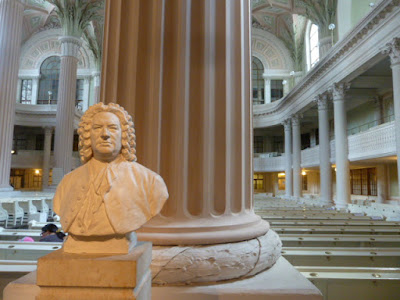The distant twin spired St Jakob, viewed from the central pedestrian area.
Life has become a little busy for me of late, as I am now well into "Saying goodbye to friends parties," and feeling rather sad at the thought of leaving Timmerlah and Braunschweig on Wednesday August 12th, to fly back to the UK.
However I will be bringing back some wonderful memories with me this year, after my visits to four places I had never previously visited. Two stand out in particular, my visit to Lüneburg with my Hamburg friends, and the other to Köthen, one of the quietest towns I have ever visited. The purpose of most of my visits is determined by whether JS Bach had lived or worked in that particular town, and my visit to Köthen was about as good as it gets.
However I will be bringing back some wonderful memories with me this year, after my visits to four places I had never previously visited. Two stand out in particular, my visit to Lüneburg with my Hamburg friends, and the other to Köthen, one of the quietest towns I have ever visited. The purpose of most of my visits is determined by whether JS Bach had lived or worked in that particular town, and my visit to Köthen was about as good as it gets.
St Jakob in the Market Place.
The historic centre of the town is a pedestrian area, and even though we visited on a market day, the place was deserted. We spoke to a young father with his child, who sat next to us on a park bench. He was born in Bavaria, but had moved to Köthen with his family in order to seek a quiet life for his children. I presume that most people who live in Köthen work in nearby Halle or Leipzig.
The historic centre of the town is a pedestrian area, and even though we visited on a market day, the place was deserted. We spoke to a young father with his child, who sat next to us on a park bench. He was born in Bavaria, but had moved to Köthen with his family in order to seek a quiet life for his children. I presume that most people who live in Köthen work in nearby Halle or Leipzig.
The Town Hall in the Market Place.
St Jakob viewed from the JS Bach memorial.
St Agnus Church, where Bach and his family worshipped.
Bach purchased a family pew in this church, and he and his family were regular worshippers here in the early 18th century. Bach´s first wife died in Köthen, and is buried in the churchyard.
Bach purchased a family pew in this church, and he and his family were regular worshippers here in the early 18th century. Bach´s first wife died in Köthen, and is buried in the churchyard.
Schloss Köthen, where Bach was the Hofkapellmeister from 1717 til 1723
A facsimile of Bach´s handwritten score, and a period violin.
Schloss Köthen, in which Bach worked as the Hofkapellmeister.




















































